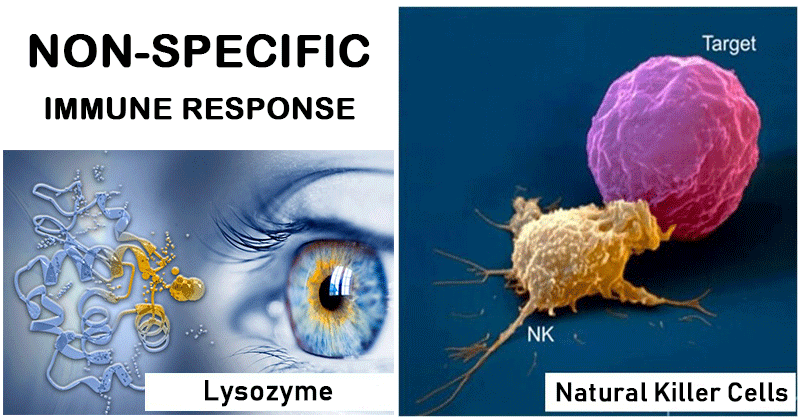- Defence mechanism refers to the ways in which the body protects itself from invasion of pathogenic organisms or other foreign materials such that it provides defence against their harmful effects.
- The defence mechanism employed may be achieved through either specific or non-specific mechanisms.
- Non-specific defence mechanisms are termed so as it offers resistance or protection against all organisms or foreign materials encountered without any specificity. This is to say that they are not directed against a particular pathogen or substance.
- Moreover, non-specific immunity lacks immunological memory because of which responses occur in same extent each time a pathogen or foreign body is encountered.
- Nonspecific defenses act sooner than specific defenses and also considered as the body’s first line of defense against diseases.
- The main objectives of these mechanisms are to prevent microorganisms from gaining a foothold in the body and to destroy them if they penetrate to the deeper tissues.
- Some components of non-specific defences are always present such as anatomic barriers, nonspecific inhibitors, and phagocytic cells while others are evoked by infection such as fever, inflammation, and interferons.

Interesting Science Videos
Defense Mechanisms that Precede Infection
- Anatomical Barriers
They exist at the body surfaces and within the body and consist of the skin and mucous membranes. They act as mechanical barriers preventing the entry of microorganisms into the body. For example intact skin prevents the introduction of pathogens due to the keratin present in addition to other acidic skin secretions such as sebum. Similarly, mucous membranes that form a large part of outer covering of gastrointestinal, respiratory, genitourinary tracts secrete mucus that forms an effective barrier, trapping pathogens.
- Physiological Barriers
Physiological barriers such as gastric acidity rendering a low pH in the stomach, lysozyme found in tears, saliva, sweat and tissue fluid dissolving cell walls of many bacteria, ear wax or cerumen trapping dust particles are effective means of elimination of pathogens.
- Cellular Barriers
They consist of phagocytic cells and natural killer cells. Phagocytes such as neutrophils, macrophages, dendritic cells present in blood, fluid or tissues of the body constitute the front line of internal defence of the host, capturing and engulfing foreign particles by the effective process of phagocytosis. Natural killer cells on the other hand act as the first line of surveillance against tumor cells and virus infected cells.
- Complements
Complements are a group of non-specific serum proteins that augment the functions of immune system. They play essential role in resistance against infection by activating a sequential cascade of active proteins that lyse foreign cells and also are the principle mediators of inflammatory response.
Besides complements, other proteins such as the acute phase proteins (such as C reactive protein) coat the surface of bacteria and lead to enhanced phagocytosis.
Defense Mechanisms Evoked by Infection
- Fever
The fever response is a hallmark of infection and inflammatory disease executed by pyrogens especially pyrogenic cytokines and confers a survival benefit during infection. The main advantages of fever response include the inhibition of microbial multiplication and increase in the metabolic rate of the body.
- Inflammation Response
Inflammation is triggered whenever body tissues are injured. It is characterized by redness, heat, swelling and pain. It prevents the spread of damaging agents, disposes cell debris and sets the stage for tissue repair.
- Interferons
They are small glycoproteins produced in response to viral infections which as a result interferes with viral replication. They play the primary protective role against naturally acquired viral infections.
References
- Dianzani F, Baron S. Nonspecific Defenses. In: Baron S, editor. Medical Microbiology. 4th edition. Galveston (TX): University of Texas Medical Branch at Galveston; 1996. Chapter 49 . Available from: https://www.ncbi.nlm.nih.gov/books/NBK8348/
- Brooks, G. F., Jawetz, E., Melnick, J. L., & Adelberg, E. A. (2010). Jawetz, Melnick, & Adelberg’s medical microbiology. New York: McGraw Hill Medical.
- Owen, J. A., Punt, J., & Stranford, S. A. (2013). Kuby Immunology (7 ed.). New York: W.H. Freeman and Company.
- Parija S.C.(2012). Textbook of Microbiology & Immunology.(2 ed.). India: Elsevier India

the importance of the acquired or adaptive immune system, which makes the vaccine prospects look good for many Coronavirus proteins. so this appears the importance of Define acquired immunity as you told that Some components of non-specific defences are always present such as anatomic barriers, nonspecific inhibitors, and phagocytic cells while others are evoked by infection such as fever, inflammation, and interferons.